Here's a quick slideshow of some of the water drop photography already showing up in the Strobist pool since Friday's tutorial post.
(NOTE: If you are reading via RSS or email, you may need to click on the post's title to view the photos.)
-30-
 Ever notice those cool water photos that drop into the Strobist Flickr Pool?
Ever notice those cool water photos that drop into the Strobist Flickr Pool?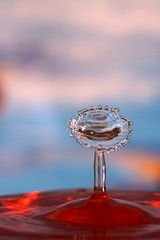 (Very cool water drop photos by Andy W., top, and Steve P., both from the Strobist Flickr Group pool. Click the pic for bigger versions.)
(Very cool water drop photos by Andy W., top, and Steve P., both from the Strobist Flickr Group pool. Click the pic for bigger versions.)



 Last but not least, remember "Newton," the mouse who invaded Jim Clark's house last winter? He was thusly named because he yielded to the laws of Newtonian physics in the process of being spectacularly captured.
Last but not least, remember "Newton," the mouse who invaded Jim Clark's house last winter? He was thusly named because he yielded to the laws of Newtonian physics in the process of being spectacularly captured.
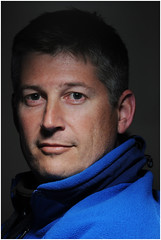 Last in this series we looked at Riaz, lit entirely by flash against a darkish wooden wall. At left is Brett, who was lit right where he sat in a classroom chair in an unfinished commercial building with a primed drywall background.
Last in this series we looked at Riaz, lit entirely by flash against a darkish wooden wall. At left is Brett, who was lit right where he sat in a classroom chair in an unfinished commercial building with a primed drywall background.
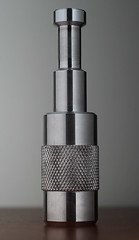 This is is a MetalHead. At least, that's what I am calling it.
This is is a MetalHead. At least, that's what I am calling it.
 I get a lot of upstream questions about lighting cars, and to be honest I am frequently at a loss what to say.
I get a lot of upstream questions about lighting cars, and to be honest I am frequently at a loss what to say. Here is the setup, minus two flashes. He used one on-camera (which traveled on-cam with this setup shot) and one in upper right that he could not get into the frame. You can see the light stand, tho.
Here is the setup, minus two flashes. He used one on-camera (which traveled on-cam with this setup shot) and one in upper right that he could not get into the frame. You can see the light stand, tho." ... Five strobes: One camera left and up high, one camera right snooted on the wheel, one up high camera right toward the rear of the car, one behind the right rear of the car, and one on camera zoomed 200mm at the front fascia. ..."
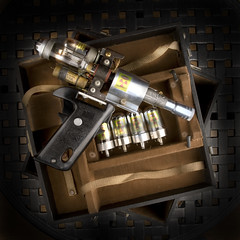 For a moment, light is taking a back seat to creativity. Strobist reader Cohophoto whipped this DIY Steampunk Ray Gun up out of parts from old radios and cameras.
For a moment, light is taking a back seat to creativity. Strobist reader Cohophoto whipped this DIY Steampunk Ray Gun up out of parts from old radios and cameras.
 The inventively named 11R Reflector (c'mon, Paul, where's that famous imagination?) is designed for long-throw sports lighting. It throws a 50-degree beam which is almost two stops brighter (1.8) than the standard 7" AlienBees / White Lightning reflector.
The inventively named 11R Reflector (c'mon, Paul, where's that famous imagination?) is designed for long-throw sports lighting. It throws a 50-degree beam which is almost two stops brighter (1.8) than the standard 7" AlienBees / White Lightning reflector. We actually tried a lot of cool stuff here, but my favorite was this daylight portrait of Brad. A White Lightning 600 with an 11R sports reflector was the main light, up high and right in front of him. You can see the hard/soft look I am talking about, and as a bonus we were able to keep the key off of the wall because of the 50-degree beam.
We actually tried a lot of cool stuff here, but my favorite was this daylight portrait of Brad. A White Lightning 600 with an 11R sports reflector was the main light, up high and right in front of him. You can see the hard/soft look I am talking about, and as a bonus we were able to keep the key off of the wall because of the 50-degree beam.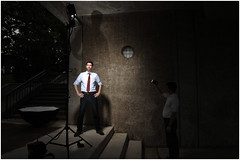 Here is the wide shot, which shows the light locations, just how far we were working over the shade ambient and even the full sun light levels nearby. This is almost all flash -- coulda shot it at midnight.
Here is the wide shot, which shows the light locations, just how far we were working over the shade ambient and even the full sun light levels nearby. This is almost all flash -- coulda shot it at midnight.

"That's the style we used to call it -- the shake and bake, you know? I used to shoot everything half a second, full second. Even when I used to shoot strobe outdoors, at nighttime, it's always one-second exposure -- to get the shake, you know?"
"Arnold Schwarzenegger was in the shake and bake period. Everything had to be shake and bake. You shoot with the tungsten light in the back, and you always shoot with the strobe in front. The front is always dark, and the back is with light.
You have a long exposure, and you can shake the camera, you know?Then the front doesn't get lit."
"Now, I don't care about flare, I don't put on the sun shade, I like to be really free. I love all this dirtiness that comes through the lens. I love it, you know? Now, even if I do strobes, it is always very dirty. I am a dirty light -- that's what I call myself."
I am very free about light. But, at the same time, I know what I am doing. I know what the light is going to do before I do it. It is gorgeous. It is sick, it is so beautiful. And that is what drives you to do great pictures. Those kinds of things -- what's next, what's next?"
 Kirk's latest book landed on my doorstep just before I headed out to Dubai, and I only now have gotten a chance to read it.
Kirk's latest book landed on my doorstep just before I headed out to Dubai, and I only now have gotten a chance to read it.
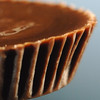 Today one of my favorite portrait photographers, Ben Baker, was profiled on Feature Shoot, one of my must-read photo sites.
Today one of my favorite portrait photographers, Ben Baker, was profiled on Feature Shoot, one of my must-read photo sites.
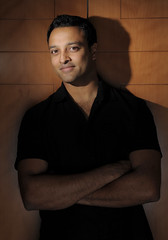 People always ask me how many flashes they should have. That's an easy one -- however many you can afford, plus one or two.
People always ask me how many flashes they should have. That's an easy one -- however many you can afford, plus one or two. 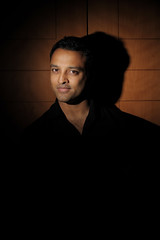 But this time we were already working with a gridded key, which by itself looked like the photo at left.
But this time we were already working with a gridded key, which by itself looked like the photo at left.
 Most of you guys like to ape great shooters. That's Dave Honl, left, shooting a great ape.
Most of you guys like to ape great shooters. That's Dave Honl, left, shooting a great ape.
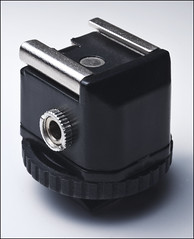 This little nubby little thing may not look like much, but it is an off-camera solution for just about any speedlight that includes manual settings. It'll give a sync jack to a camera, too.
This little nubby little thing may not look like much, but it is an off-camera solution for just about any speedlight that includes manual settings. It'll give a sync jack to a camera, too.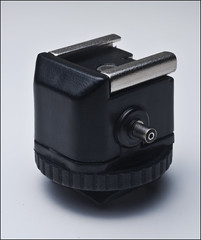 It features a hot shoe on top and bottom, and dual sync options for corded use. Like the LumoPro LP120 (the first production run of which is sold out, with more expected in a few days) it has both a PC sync and a 1/8" minijack sync.
It features a hot shoe on top and bottom, and dual sync options for corded use. Like the LumoPro LP120 (the first production run of which is sold out, with more expected in a few days) it has both a PC sync and a 1/8" minijack sync.

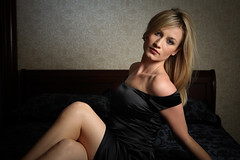 One of my biggest apprehensions before the week was having no idea where the students would be, ability-wise, when they arrived. Would some of them be long-time pros? Would some be rank beginners? Worse yet -- maybe a mix of both?
One of my biggest apprehensions before the week was having no idea where the students would be, ability-wise, when they arrived. Would some of them be long-time pros? Would some be rank beginners? Worse yet -- maybe a mix of both?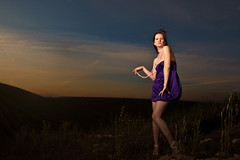 Many people look at lighting as a technical thing. In reality it is about as technical as playing with the bass and treble knobs on your stereo. And about as difficult, truth be told. I would rather be math-challenged and very creative and be learning this stuff than to be an engineer with the same goal.
Many people look at lighting as a technical thing. In reality it is about as technical as playing with the bass and treble knobs on your stereo. And about as difficult, truth be told. I would rather be math-challenged and very creative and be learning this stuff than to be an engineer with the same goal.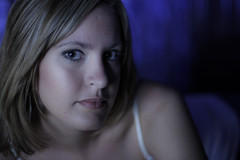 Syl Arena is the proprietor of Paso Robles Workshops, where we were all learning together. (Syl's the guy under he mop of red hair at center left.) He and I originally planned on forming the class into teams based on their brand of gear and various synching methods. In the end we ended up rotating them into a completely new group every day, making for a more diverse experience for the whole class.
Syl Arena is the proprietor of Paso Robles Workshops, where we were all learning together. (Syl's the guy under he mop of red hair at center left.) He and I originally planned on forming the class into teams based on their brand of gear and various synching methods. In the end we ended up rotating them into a completely new group every day, making for a more diverse experience for the whole class.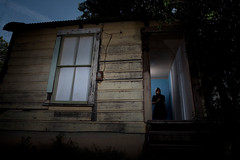 After this week I feel even more strongly that the key to understanding lighting is to become very comfortable with the concept of balance. We have talked about it in L101 and L102, and in just about every OA post. But everything comes down to how well you understand this concept. All of the other stuff is icing on the cake.
After this week I feel even more strongly that the key to understanding lighting is to become very comfortable with the concept of balance. We have talked about it in L101 and L102, and in just about every OA post. But everything comes down to how well you understand this concept. All of the other stuff is icing on the cake.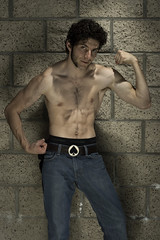 Once you get the concept, play. A lot. That is a big part of the strength of a five-day workshop -- total immersion learning. I demo'd on Monday, and they shot every other day.
Once you get the concept, play. A lot. That is a big part of the strength of a five-day workshop -- total immersion learning. I demo'd on Monday, and they shot every other day. 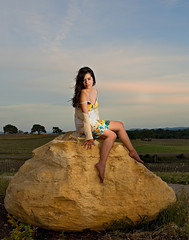 Lots of rookie lighting photogs crash here. They spend so much energy working out the light that they neglect the most important part of the process. Save your subjects' attention spans for when you are done with the lighting tweaks away and ready to start making photos.
Lots of rookie lighting photogs crash here. They spend so much energy working out the light that they neglect the most important part of the process. Save your subjects' attention spans for when you are done with the lighting tweaks away and ready to start making photos. 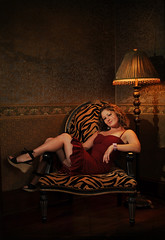 The dynamic of team learning is hard to beat. Go to a meetup. Find another local shooter and practice some together. They understand you way better than your poor spouse does. Another lighting photographer will be a VAL (voice-activated light stand) or VAB (same, but a boom) for you until their arms fall off, simply because they want to see what the light can do from way up there, too.
The dynamic of team learning is hard to beat. Go to a meetup. Find another local shooter and practice some together. They understand you way better than your poor spouse does. Another lighting photographer will be a VAL (voice-activated light stand) or VAB (same, but a boom) for you until their arms fall off, simply because they want to see what the light can do from way up there, too.